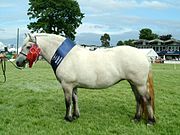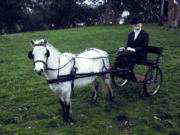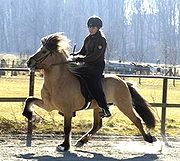
Pony
Background to the schools Wikipedia
SOS Children, which runs nearly 200 sos schools in the developing world, organised this selection. Before you decide about sponsoring a child, why not learn about different sponsorship charities first?
A pony is a small horse with a specific conformation and temperament. There are many different breeds of ponies. Compared to horses, ponies often exhibit thicker manes, tails and overall coat, as well as proportionally shorter legs, wider barrels, heavier bone, thicker necks, and shorter heads with broader foreheads.
Ponies are generally considered intelligent and friendly, though sometimes they also are described as stubborn or devious. The differences of opinion often result from an individual pony's degree of proper training. Ponies trained by inexperienced individuals, or only ridden by beginners, can turn out to be spoiled because their riders typically lack the experience base to correct bad habits. Properly trained ponies are appropriate mounts for children who are learning to ride. Larger ponies can be ridden by adults, as ponies are usually very strong.
The pony originated from original wild horse prototypes that developed small stature due to living on the margins of livable horse habitat. These smaller animals were domesticated and bred for various purposes all over the Northern hemisphere.
Ponies were historically used for driving and freight transport, as children's mounts, for recreational riding, and later as competitors and performers in their own right. During the Industrial Revolution, particularly in Great Britain, a significant number were used as " pit ponies," hauling loads of coal up from the mines.
Horses and ponies
For many forms of competition, the official definition of a pony is a member of equus caballus that measures less than 14.2 hands (hh) (1.47 meters or 58 inches) at the withers. Horses are 14.2 or taller. However, the term "pony" can be used in general (or affectionately) for any small horse, regardless of its actual size or breed. Furthermore, some horse breeds may have individuals who mature under 14.2 but are still called "horses" and are allowed to compete as horses. In Australia horses that measure from 14 hands to 15 hands are known as a galloway. Thus ponies in Australia measure under 14 hands.
People who are unfamiliar with horses may confuse an adult pony with a young, immature horse. While foals that will grow up to be horse-sized may be no taller than some ponies in their first months of life, they are very different. A pony can be ridden and put to work, while a foal is too young to be ridden or used as a working animal. Foals, whether they grow up to be horse or pony-sized, can be distinguished from adult horses by their extremely long legs and slim bodies. Their heads and eyes also exhibit juvenile characteristics. Furthermore, in most cases, nursing foals will be in very close proximity to a mare who is the mother (dam) of the foal. While ponies exhibit some neoteny with the wide foreheads and small size, their body proportions are similar to that of an adult horse.
Uses
Ponies are seen in many different equestrian pursuits. Some breeds, such as the Hackney pony, are primarily used for driving, while other breeds, such as the Connemara pony and Australian Pony, are used primarily for riding. Others, such as the Welsh pony, are used for both riding and driving.
Ponies compete at events ranging from hunters, English riding on the flat, harness, and western riding classes at horse shows, to other competitive events such as gymkhana and combined driving. They are seen in casual pursuits such as trail riding. Ponies also are shown in dressage, equitation, and other events, even in international-level competition. Though many exhibitors confine themselves to classes just for ponies, top ponies are competitive against full-sized horses. For example, a 14.1 hand pony named Stroller was a member of the British Equestrian show jumping team, and won the silver medal at the 1968 Summer Olympics. More recently, the 14.1-3/4 hand pony Theodore O'Connor won the gold medal in eventing at the 2007 Pan American Games. There is no direct correlation between a horse's size and its inherent athletic ability.
Pony Clubs, open to young people who own either horses or ponies, are formed worldwide to educate young people about horses, promote responsible horse ownership, and also sponsor competitive events for young people and smaller horses.
In many parts of the world ponies are also still used as working animals, as pack animals and for pulling various horse-drawn vehicles. They are sometimes seen at traveling carnivals, or at children's private parties where small children can take short rides on ponies that are saddled and then either led individually or hitched to a "pony wheel" (a non-motorized device akin to a hot walker) that leads six to eight ponies at a time. Ponies are sometimes seen at summer camps for children, and in some places, particularly Ireland and the UK, larger ponies may even carry adults on Equitourism vacations.
Breeds and types
Pony breeds have developed all over the world, particularly in cold and harsh climates where hardy, sturdy, working animals were needed. The "Four foundations theory" suggests that ponies, particularly in Europe, may have descended from the "draft" subspecies of Equus ferus. Nearly all pony breeds share the ability to thrive on a more limited diet than that of a regular-sized horse, and are remarkably strong for their size. Some breeds, such as the Shetland pony are able to pull as much weight as a draft horse. Others, such as the Connemara pony, are recognized for their ability to carry a full-sized adult rider.
For showing purposes, ponies are often grouped into small, medium, and large sizes. Small ponies are 12.2 hands (1.27 meters or 50 inches) and under, medium ponies are over 12.2 but no taller than 13.2 hh (1.37 meters or 54 inches), and large ponies are over 13.2 hh but no taller than 14.2 hh (1.47 meters or 58 inches).
The smallest equines are called miniature horses by many of their breeders and breed organizations, rather than ponies, but stand smaller than small ponies, usually no taller than 34 to 38 inches at the withers.
Breeds that are not ponies
Some horse breeds are not considered ponies, even when they have some animals that measure under 14.2 hands. This is usually due to body build, traditional uses and overall physiology. Breeds that are considered horses regardless of height include the Arabian horse, American Quarter Horse and the Morgan horse, all of which have individual members both over and under 14.2 hands.
Other horse breeds, such as Icelandic Horse and Fjord Horse, may sometimes be pony-sized or have some pony characteristics, such as a heavy coat, thick mane, and heavy bone, but are generally classified as "horses" by their respective registries. In cases such as these, there can be considerable debate over whether to call certain breeds "horses" or "ponies." However, individual breed registries usually are the arbiters of such debates, weighing the relative horse and pony characteristics of a breed. In some breeds, such as the Welsh pony, the horse-versus-pony controversy is resolved by creating separate divisions for consistently horse-sized animals, such as the "Section D" Welsh Cob
Some horses may be pony height due to environment more than genetics. For example, the Chincoteague pony, a feral horse that lives on Assateague Island off the coast of Virginia, often matures to the height of an average small horse when raised from a foal under domesticated conditions.
Conversely, the term "pony" is occasionally used to describe horses of normal height. Horses used for polo are often called " polo ponies", though in the United States and the United Kingdom, they are often of Thoroughbred breeding and often well over 14.2 hands. American Indian tribes also have the tradition of referring to their horses as "ponies," when speaking in English, even though many of the Mustang horses they used in the 19th century were close to or over 14.2 hh, and most horses owned and bred by Native peoples today are of full horse height. The term "pony" is also sometimes used to describe a full-sized horse in a humorous or affectionate sense.
In some registries, such as the American Miniature Horse Association, a miniature horse is also not considered a pony--it is a small horse, under 8.2 hh (86 cm, or 34 in) at the withers. However, there are also miniature pony breeds.










